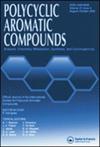橡胶热解生成多环芳烃的分子动力学模拟
IF 2.6
3区 化学
Q2 CHEMISTRY, ORGANIC
引用次数: 0
摘要
汽车工业的快速扩张给废轮胎橡胶行业带来了挑战。热解作为废橡胶处理的主要方法,不可避免地会产生多环芳烃,多环芳烃是二恶英的前体,具有很高的毒性。本研究利用分子动力学模拟研究了橡胶大分子的热分解和随后形成的多环芳烃。首先对热解过程进行整体模拟,分析热解产物的演化过程。橡胶的热解过程涉及到顺序分解和聚合,通过对不同碳原子数的分解产物的演化分析来验证这一过程。随后,检查和评估影响多环芳烃形成的因素。温度升高促进橡胶热解,而多环芳烃分子的成熟度与氧水平有关。氢或羟基的引入可以部分阻止多环芳烃的产生。本研究旨在阐明橡胶热解过程中多环芳烃生成的调控机制,为有效调控废橡胶热解过程中多环芳烃的产生提供依据。本文章由计算机程序翻译,如有差异,请以英文原文为准。

Molecular Dynamics Simulation of PAHs Generated from Rubber Pyrolysis
The rapid expansion of the automotive industry has posed challenges for the waster tire rubber sector. Pyrolysis, as a prominent method for waster rubber treatment, inevitably produces polycyclic aromatic hydrocarbons (PAHs), which serve as precursors to dioxins and exhibit high toxicity. This study utilizes molecular dynamics simulations to investigate the thermal decomposition of rubber macromolecules and the subsequent formation of PAHs. Initially, an overall simulation of the pyrolysis process is conducted to analyze the evolution of pyrolysis products. The pyrolysis of rubber involves sequential decomposition and polymerization, with the evolutionary analysis of the decomposition products with various numbers of carbon atoms used to validate this process. Subsequently, the factors influencing PAH formation are examined and assessed. Temperature elevation enhances rubber pyrolysis, while the maturity of PAH molecules is linked to oxygen levels. The introduction of hydrogen or hydroxyl groups can partially impede PAH generation. This investigation elucidates the mechanisms governing PAH generation during rubber pyrolysis, with the goal of aiding in the effective regulation of PAHs in waster rubber pyrolysis.
求助全文
通过发布文献求助,成功后即可免费获取论文全文。
去求助
来源期刊

Polycyclic Aromatic Compounds
化学-有机化学
CiteScore
3.70
自引率
20.80%
发文量
412
审稿时长
3 months
期刊介绍:
The purpose of Polycyclic Aromatic Compounds is to provide an international and interdisciplinary forum for all aspects of research related to polycyclic aromatic compounds (PAC). Topics range from fundamental research in chemistry (including synthetic and theoretical chemistry) and physics (including astrophysics), as well as thermodynamics, spectroscopy, analytical methods, and biology to applied studies in environmental science, biochemistry, toxicology, and industry. Polycyclic Aromatic Compounds has an outstanding Editorial Board and offers a rapid and efficient peer review process, as well as a flexible open access policy.
 求助内容:
求助内容: 应助结果提醒方式:
应助结果提醒方式:


